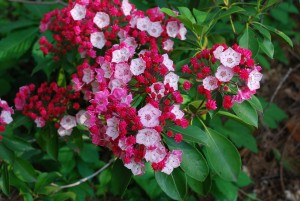Mountain laurel (Kalmia latifolia) is a U.S. native evergreen broadleaf shrub (USDA hardiness zone 5). Mature sizes range from 5 feet (dwarf cultivars) to 12 feet in height and with equal spread. Over the past 30 years, mountain laurels have so improved, thanks to breeding efforts of Dr. Richard Jaynes*. He has released several dozen cultivars to date, including those with dwarf forms and with highly colorful flowers.
Flowers open over a two week period beginning in mid-May here in the Southern Appalachian region (USDA hardiness zones 6 and 7). In the wild, mountain laurel tends to grow near a woodland clearing. In the garden, plant in an open area for full or partial sunlight. Mountain laurel prospers a cool, moist, acidic (pH 6 or below preferred), compost rich soil which is well drained. Flowers and foliage are best protected from direct wind.
Pruning is best performed within a few weeks after flowering is finished. Prune to shape, to limit shrub height and width, and to remove dead or diseased twigs and branches. Pruning and feeding with an acidic water soluble fertilizer such as Miracle-Gro®, Hollytone® or Schultz® invigorates new growth and flowering the next year. Mountain laurel tolerates droughty soils once established for two years.
Mountain laurels tend to perform more reliably than rhododendrons. While several plant maladies are possible, gardener should be most aware of phytophthora root rot in poorly drained soils and lace bug damage on the spring/summer foliage.
*Dr. Jaynes’ book: “Kalmia: Mountain Laurel and Related Species”, 3rd ed.(Timber Press).
Next blog: list and descriptions of ten favorite kalmia cultivars.


 Posted in
Posted in 
